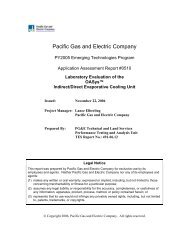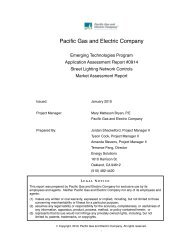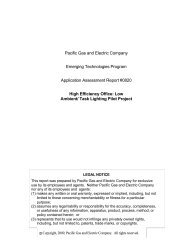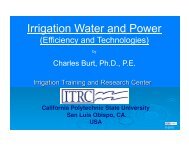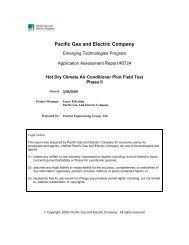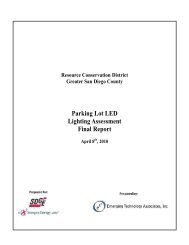Pacific Gas and Electric Company - Emerging Technologies ...
Pacific Gas and Electric Company - Emerging Technologies ...
Pacific Gas and Electric Company - Emerging Technologies ...
You also want an ePaper? Increase the reach of your titles
YUMPU automatically turns print PDFs into web optimized ePapers that Google loves.
Evaluation of the Freus Residential Evaporative Condenser System in PG&E Service Territory<br />
Market Barriers <strong>and</strong> Installation Challenges<br />
Freus is currently struggling against many of the market barriers common to emerging<br />
technologies. The key market barriers to greater implementation of evaporative condensers are<br />
incremental cost, long-term product reliability, <strong>and</strong> development of a robust manufacturer<br />
support network for contractor training, field support, <strong>and</strong> parts availability. The cost issue is the<br />
classic chicken-<strong>and</strong>-egg problem, since increased volume is needed optimize production<br />
capabilities <strong>and</strong> reduce supplier costs. Utility or Public Utilities Commission incentives<br />
extending over a multi-year period would be beneficial in spurring the market. Production<br />
homebuilders will move cautiously until they see evidence of demonstrated product reliability<br />
<strong>and</strong> favorable economics. As with any emerging technology, education for homeowners <strong>and</strong><br />
HVAC contractors is needed to ensure that the expected performance is achieved in the field.<br />
Manufacturer training <strong>and</strong> certification of HVAC contractors would be a valuable step in<br />
properly training contractors on system sizing, coil <strong>and</strong> expansion valve selection, refrigerant<br />
charging, <strong>and</strong> other installation details.<br />
Conclusions<br />
Residential evaporative condensers offer significant benefits for California <strong>and</strong> other hot/dry<br />
climates. By effectively limiting refrigerant condensing temperatures through evaporative<br />
processes, significant energy <strong>and</strong> dem<strong>and</strong> savings exist relative to 13 SEER air conditioning. In<br />
addition, evaporative condensers provide identical indoor comfort to st<strong>and</strong>ard air-cooled<br />
equipment, allowing the technology to be acceptable to a broader segment of the residential<br />
market than other efficient evaporative systems that create higher indoor humidity levels.<br />
This project monitored two Freus installations in PG&E territory; completed simulation<br />
projections to assess energy, dem<strong>and</strong>, <strong>and</strong> cost savings; <strong>and</strong> assessed contractor <strong>and</strong> homeowner<br />
satisfaction with the unit. Specific project conclusions include:<br />
1. Simulation projections, based on project monitoring results, suggest cooling energy<br />
savings of 21-33% for typical Central Valley applications 18 relative to conventional 13<br />
SEER air conditioning. Average savings are estimated at 725 kWh/year, resulting in<br />
typical homeowner cost savings of $203 annually. Coincident peak cooling dem<strong>and</strong><br />
savings over the Noon to 7 PM summer period range from 22-35%. Projected peak hour<br />
savings will be higher, as the evaporative condenser performance advantage increases as<br />
outdoor temperatures rise. (Projected percentage savings for the new construction cases<br />
are higher since cooling loads are more concentrated in the hottest part of the day, but<br />
absolute savings are higher for the retrofit due to higher loads.)<br />
2. Monitoring results from the Elk Grove site indicate that evaporative condensers reduce<br />
condensing unit peak dem<strong>and</strong> by ~50% relative to a 9.5 SEER air-cooled unit monitored<br />
at the same site. This level of peak dem<strong>and</strong> reduction is likely representative for retrofit<br />
applications, but is high for new construction applications where 13 SEER units are<br />
typically installed.<br />
18 Results were generated based on an 1,882 ft 2 single-story prototype house modeled both as a new Title 24<br />
compliant case, as well as a 20 year old existing house with lower quality glazing, less ceiling insulation, <strong>and</strong> leakier<br />
attic ducts.<br />
© Copyright, 2008, <strong>Pacific</strong> <strong>Gas</strong> <strong>and</strong> <strong>Electric</strong> <strong>Company</strong>. All rights reserved.<br />
Page 22



